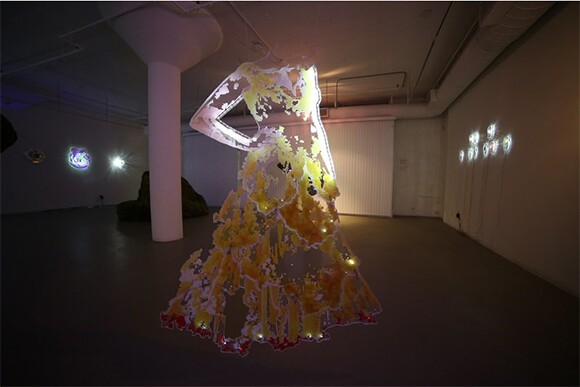Miri Chais: Where Internet Life and IRL Meet

"Red Moment" hangs near the front of a small gallery inside Miri Chais' studio. It's a figure of a young, headless woman cut from plexiglass. The piece is based on Miley Cyrus in one of her own red carpet moments. However, without a face, the singer is difficult to recognize. She becomes an anonymous, perfect figure posed hand-on-hip. Her yellow dress, highlighted by small LEDs, meets with the bright red symbolic of a carpet best known for celebrities, camera flashes and shallow interviews. She's a physically perfect woman whose image will be shared and scrutinized over the next few days.
When Chais moved to Los Angeles a little over a year ago, she heard things like "You can do anything, it's L.A. It's Hollywood." and "What do you expect? It's Hollywood." That culminated in "Red Moment," a depiction of the images that Los Angeles feeds out to the rest of the world with every movie premiere and awards show. "They're working so hard to be so perfect in this moment," she says. "That was an immediate response I had to moving here."
A split second of perfection can take a lifetime to attain and that one moment may not seem so perfect once the photographic reminder spreads far and wide across the Internet. The image will be subject to criticism and praise. It's meaning will change as it passes from user to user. That rapid fire evolution of images and symbols is at the heart of Chais' work.
Augmented from Miri Chais on Vimeo.
Before art, Chais worked in advertising as a media planner. She wasn't doing the creative work, but, she surmises that the iconography that drives the advertising industry must have made an impact on her. She was in her 30s when she went to art school and has spent the past half-decade or so building up her second career. She showed in a number of events in Israel, where she lived until recently. Her work has also appeared in Japan and Germany. Since moving to Los Angeles with her family, she has contributed pieces to several exhibitions in her new home base.
Chais' work is concerned with the intersection between the physical world and the digital one. Back in the early days of the Internet, we would reference IRL, an abbreviation of "in real life," or our life away from the chat rooms and instant messaging sessions. As time has passed, those two realms have overlapped in ways that still seemed remote in the 1990s. "We know people through Facebook," says Chais. "You feel like you know someone in the real world." Chais' questions go beyond the basics of these global connections that come about through social media sites. "If you experience something in reality or in the virtual world, how does it affect you?" she asks. Chais wants to know how meanings changes as messages move across the web. Moreover, she wants to know if something needs a virtual footprint to prove its existence.

Chais works her way through these questions inside the Beacon Arts Building in Inglewood, where she has a studio. She makes large installations built from layers of plexiglass filled with digital images, marked by etchings and lit up by LEDs. Some feature video. Some are accompanied by sound collages when on display. All comment on 21st century life. In "Rabbit Hole," Chais embeds an image of a Pokémon character and a large anime-style eye inside the work. In "Augmented Garden," each piece takes the form of a large, moss-covered rock. The rocks, though, contain prisms, which are filled with snapshots of video games. Chais took the photos while her son played the games. It's not simply pop culture that affects Chais' work. It's the sort of pop culture that spawns memes and viral hits, a culture that exists for those who float between smart phones and laptops throughout the day.

The most prominent, repeated icon in Chais' work is Amy Winehouse. The late singer appears in Death and the Maiden primarily as an outline of a thin face and narrow shoulders. It's the hair that is obviously Winehouse, dark and piled into a beehive with a rose fastened to the side of the 'do. Chais remembers when she first heard the singer. "I didn't know who is she or how she looked, but there was something so intriguing about her," she says. "I wanted to know everything about her." It's more than Chais' own admiration of Winehouse's music that inspired the artworks. She sees the singer as an "icon" of the social media age. Her retro-modern sound, and matching look, took off as Internet users were first logging onto Facebook. Her demise was documented in one shocking photo after the next, as armchair critics offered their assessment of the singer's health in a barrage of posts. "Everything was transparent," says Chais. "You could see her when she was in the lowest possible situation." This, Chais explains, makes Winehouse different from Jim Morrison, Janis Joplin and other artists who tragically succumbed to their addictions at a young age. The cruelty of the comments directed towards Winehouse make a difference too. "There isn't any filter anymore," she says.
It's in that mix of creativity and tragedy that makes Winehouse stand out as emblematic of Chais' thesis. "Everything has an advantage and disadvantage," she says. On the screens that suck so much of our time, we see the amazing feats of creativity of which people are capable. We also see the depths of sorrow and the cruelty of the crowd. Somewhere in the midst of that, Chais is commenting through large, detailed installations that are, almost ironically, best viewed IRL.
Dig this story? Sign up for our newsletter to get unique arts & culture stories and videos from across Southern California in your inbox. Also, follow Artbound on Facebook and Twitter.


